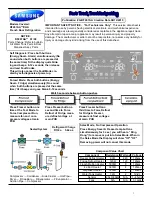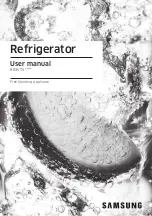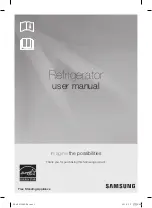
GB
Instruction for use
Defrosting
A) Fridge compartment
The fridge compartment defrosts
automatically. The defrost water runs to the
drain tube via a collection container at the
back of the appliance
(Item 6)
.
During defrosting, water droplets may form at
the back of the fridge compartment where a
concealed evaporator is located. Some
droplets may remain on the liner and refreeze
when defrosting is completed. Do not use
pointed or sharp-edged objects such as
knives or forks to remove the droplets which
have refrozen.
If, at any time, the defrost water does not
drain from the collection channel, check that
no food particles have blocked the drain tube.
The drain tube can be cleared with a pipe-
cleaner or similar implement.
Check that the tube is permanently placed with
its end in the collecting tray on the compressor
to prevent the water spilling on the electric
installation or on the floor
(Item 7)
.
B) Freezer compartment
Defrosting is very straightforward and without
mess, thanks to a special defrost collection
basin.
Defrost twice a year or when a frost layer of
around 7 (1/4") mm has formed. To start the
defrosting procedure, switch off the appliance
at the socket outlet and pull out the mains
plug.
All food should be wrapped in several layers
of newspaper and stored in a cool place (e.g.
fridge or larder).
Containers of warm water may be placed
carefully in the freezer to speed up the
defrosting.
Do not use pointed or sharp-edged
objects, such as knives or forks to remove
the frost.
Never use hairdryers, electrical heaters or
other such electrical appliances for defrosting.
Sponge out the defrost water collected in the
bottom of the freezer compartment. After
defrosting, dry the interior thoroughly
(Item 8
& 9)
. Insert the plug into the wall socket and
switch on the electricity supply.
Changing the illumination lamp
To change the lamp used for illumination of
your refrigerator, please call your Authorized
Service.
Cleaning and care
1. We recommend that you switch off the
appliance at the socket outlet and pull out the
mains plug before cleaning.
2. Never use any sharp instruments or
abrasive substances, soap, household
cleaner, detergent or wax polish for cleaning.
3. Use luke warm water to clean the cabinet
of the appliance and wipe it dry.
4. Use a damp cloth wrung out in a solution
of one teaspoon of bicarbonate of soda to one
pint of water to clean the interior and wipe it
dry.
5. Make sure that no water enters the
temperature control box.
6. If the appliance is not going to be used for
a long period of time, switch it off, remove all
food, clean it and leave the door ajar.
7. We recommend that you polish the metal
parts of the product (i.e. door exterior, cabinet
sides) with a silicone wax (car polish) to
protect the high quality paint finish.
8. Any dust that gathers on the condenser,
which is located at the back of the appliance,
should be removed once a year with a
vacuum cleaner.
9. Check door seals regularly to ensure they
areclean and free from food particles.
10. Never:
• Clean the appliance with unsuitable material;
eg petroleum based products.
• Subject it to high temperatures in any way,
• Scour, rub etc., with abrasive material.
11. Removal of dairy cover and door tray :
• To remove the dairy cover, first lift the cover
up by about an inch and pull it off from the
side where there is an opening on the cover.
• To remove a door tray, remove all the
contents and then simply push the door tray
upwards from the base.
5
Содержание CSA24031X
Страница 2: ......
Страница 5: ...1 ...
Страница 6: ...2 3 4 9 5 6 7 8 ...
Страница 7: ...10 ...
Страница 42: ...4578331420 AC EN CZ SK PL ...
Страница 43: ......
Страница 44: ...4578331420 AC EN CZ SK PL ...













































